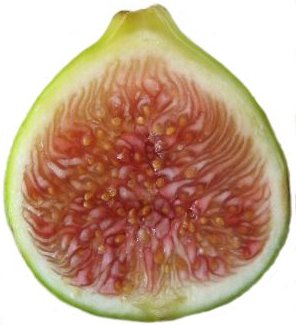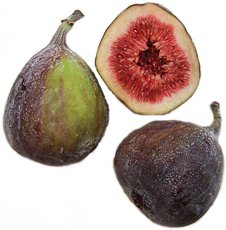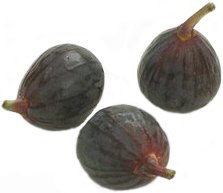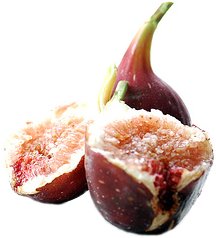

Figs

Ficus Carica (Moraceae). The fig, one of the oldest fruits known to civilisation (certainly to 2700BC), is said to have its origins in the deep valleys of the Tajik mountains in Transcaucasia and has long since been native to the Southwest Asia-Eastern Mediterranean regions. There are numerous references to the fig in the bible; today it is also found growing wild in much of southern Europe and North Africa. Its fruits have always been greatly prized not only for their nutritious food value but also because of their capacity for drying and subsequent storing. Moreover, a well-grown fig tree offers good shade from the summer sun. References in their praise and describing their cultivation reach back to the earliest known records of civilisation and the remains of figs have been found in many excavations in ancient settlements in a broad arc from Egypt to Greece and Crete, Rome, Western Europe and Britain. The Phoenicians are credited with the introduction of the fig to many countries in their extensive travels, including India and China. Likewise, the Romans extended its domestic cultivation westwards and northwards into Europe and to Britain. Subsequently it was introduced across the world to be cultivated in many countries whose climate is conducive to success. Today the fig is grown widely and commercial plantations are found notably in California, Turkey, southern Europe and North Africa. Its history in Britain is linked with the Romans. The fig was prominent in their diet; dried samples were imported from Italy, and fig seeds have been found at several Roman sites. However, no substantial evidence of its cultivation occurs until the 16th and 17th centuries, by which time it was being cultivated by some of the wealthy. Few cultivars existed in Britain, though many more have long since been recognised in France and the Mediterranean region, and progress was hindered by a climate marginal for success even in the favoured South of England. Early in the 18th century, Phillip Miller imported many new cultivars from continental Europe. The best of these were later selected, including ‘Brown Naples’ (later to be renamed ‘Brown Turkey’) which is still the most widely grown cultivar in the UK. There followed an increased interest in figs; the necessity for warm wall culture other than in a few very favoured open sites was already established, as was the need to protect the branches from severe frosts. By the late 18th century nurserymen were listing as many as 15 cultivars including ‘White Marseilles’, considered to be among the finest for flavour. In 1826 the Horticultural Society had 75 cultivars in its collection at Chiswick, though many were synonyms of duplicates, and by now the large estate gardens were perfecting the cultivation of the fig not only on suitable warm walls but also in glasshouses, some heated. This was continued and extended throughout the 19th century and well into the 20th century, until the final decline of the great country estates following World War II. Perhaps the most famous of figs is the very ancient, high-quality ‘Smyrna’, much prized for drying. It originates from the place of that name (now Izmir) in Turkey. In common with many of the older fig selections once grown, it relies for fertility on the very small fig wasp (Blastophaga psenes) which breeds inside the wild form of fig, known as caprifig. Without cross-pollination, or caprification (the specific term used to describe this very specialised form of it), the Smyrna fig is not fertilised and therefore does not mature. The process of caprification is the attraction of the fig wasp, as it emerges covered in pollen from the wild male caprifigs, to the female flowers of the ‘Smyrna’. The flowers of the fig are enclosed in a fleshy receptacle with a narrow opening at the extremity through which the wasp gains entry, thereby effecting cross-pollination. This natural yet elaborate process is recorded by Aristotle, and by Pliny in some detail. Fortunately present-day cultivars are self-fertile, which greatly facilitates cultivation. 
It is comparatively easy to grow figs successfully given a favourable situation, restricted root run and a reliable cultivar, even in cool temperate regions. It is generally accepted that a warm wall is essential for consistently good cropping in such cool-temperate climates. It not only greatly aids the ripening of the fruit, which it may also shield from rain, but also gives considerable protection from severe winter weather. If a tree is to be tried in open ground, it will require as sheltered, warm and sunny a position as can be found. Damage will occur following severe frosts but sucker growth will usually supply replacement branches, if coupled with judicious pruning out of damaged wood. Soil need not be other than ordinary and success on chalk is likely. However, excesively high pH readings (7.5 and upwards) are to be avoided. Equally, small amounts (120g/m²) of lime as ground chalk should be incorporated where pH is less than 6.0. Too rich a soil is likely to encourage overly strong growth at the expense of fruiting. Whatever the soil, adequate restriction of the root run is one of the keys to success. This is achieved by the construction of a brick or concrete-lined bed some 75cm long and 60cm wide and deep. The base should either contain one or two drainage holes or be layered with 30cm of broken brick and stone. This automatically constrains root development, with a proportional limitation on shoot growth that aids training and encourages successful fruiting. The fig is one of the few tree fruits which is not grafted on to a rootstock (although the availability of a rootstock to induce dwarfing might well increase the fruit’s popularity). Trees are usually available from fruit nurserymen, often as two-year-old specimens and pot grown, in which case it will be important to ensure that the roots are not potbound – if they are, establishment and suitable growth may well be hindered. Planting in late summer or early spring is advised to avoid any risk of frost damage to the young tree. Cultivars available and successful in cooler regions are very limited. The most reliable and widely grown is ‘Brown Turkey’ (mid-season). Others include ‘White Marseilles’ (early), ‘Brunswick’ (mid-season) and ‘Bourjasotte Grise’ (late). The last-named requires a particularly warm, favoured site to finish and ripen properly. Fruit shape varies according to cultivar, from round-turbinate to long pear-shaped, size also. Large-fruited cultivars include ‘Black Genoa’ and ‘White Marseilles’, two of a number that are grown in Australia, where some new locally bred cultivars are becoming available. Here, in common with suitable climatic regions such as southern Europe, the range of cultivars offering success is much greater. Skin colour of the ripe fruit also varies widely depending on cultivar – from ‘white’ (in reality, pale creamy green) through green-yellow, green, brown and purple to almost black. 
The best tree form for wall training is the fan, with the tree planted some 22cm from the wall. For this the same principles of branch formation described for apple should be followed, but laying the main branches at a wider spacing (about 30cm) to take account of the large, luxuriant leaves. In two or three years the wall space should be adequately covered by the main ‘ribs’ or branches and it is the succession of young growths from these that will provide the fruit. At this point the unusual fruiting habit of the fig needs to be appreciated. In its natural habitat, with long, warm, dry, summers, two or sometimes three crops are produced. This is accomplished by the young shoots developing fruitlets in their leaf axils as they grow; the first, small, early summer crop arises from minute fruitlets formed the previous autumn. In succession develops a bigger main crop, and occasionally a smaller third crop. Such a sequence is impossible in the open in cool climates but the use of a slightly heated greenhouse will certainly enable two crops to be ripened. The open-ground and wall-trained trees will depend on the minute, embryo fruits that form towards the tips of short laterals at the end of the summer and early autumn. These fruits are no larger than a small pea, can be damaged by sharp frosts and must be protected by covering the branches with bracken or other suitable material until the risk has passed. Successfully overwintered, they then have the capacity to develop and ripen in the next late summer to early autumn. Any fruits that grow on young, newly formed shoots will have insufficient time and warmth to ripen in the British climate and will eventually turn yellow and drop: they cannot overwinter. To assist the ripening crop, it is helpful to remove these immature fruits by hand so that the tree’s resources are not wasted on them. The skill of fig cultivation in Britain lies in the encouragement of suitable short growths from just after mid-summer onwards. These should then develop the small embryo figs near the tips that can successfully overwinter and then grow and ripen the next season. To accomplish this, shoots should be pinched at the fourth or fifth leaf and no later than the end of June. This encourages the production of more short shoots that should later carry the required embryo fruits. Excessive vigour is common and the regular pruning and thining of growths is essential to avoid trees being overgrown. Once in this state, shoots are denied adequate space and light and cropping is reduced greatly. Each year in late winter, once the risk of severe frost is past, some thinning of growth is necessary. Firstly, old wood should be cut out, also any that may be frost-injured. Of younger shoots those growing at awkward angles (e.g. inwards, towards the wall) should be removed; a portion of the remainder should be cut back hard to encourage new growth from near the branch and the remainder left intact to carry their crop. 
In warmer climates plantations of goblet-shaped bushes are grown with up to five or six branches and with a 6-9m spacing. Pruning and thinning may need to be quite severe, especially on cultivars of spreading habit. The retention of some growth at the tree centre is often called for to reduce the risk of sunburn on the bark. Suckers need removal at an early stage. Pruning detail will depend commercially on which of the crops is the most important. Thus if the first crop (i.e. that developing from the previous autumn’s embryo fruits) is a primary requirement there must be minimum removal of the crop-bearing shoots. Australian practice is to pinch out the tips of the fruit-bearing shoots, also to thin out any later fruits that form to channel maximum resources to the ripening early crop, which frequently gives the greatest financial return. If the accent is on the second crop destined for late summer-autumn ripening, pruning consists of cutting back young shoots in winter by about half their length. This removes the potential crop to ensure the production of a maximum second crop. Feeding regimes in cooler climates should include only small amounts of nitrogen and then only if growth is lacking. Regular light applications of potash, particularly in the form of weak liquid feeds every 2-3 weeks in summer, assist fruit quality and disease resistance and help to supplement a winter application of sulphate of potash of 14g/m². On soils known to be below pH 6.0, lime in the form of ground chalk should be applied in late winter at 120g/m² every two or three years. Wall-trained trees may need watering in summer, particularly where roots are confined in a lined bed, but not as ripening approaches. Farmyard manure (not fresh) applied as a surface mulch in spring will conserve moisture and help nutrition generally. In hotter, drier countries where growth and cropping are much heavier, rather more nitrogen may be necessary to replenish reserves, but even here any excess will cause unwanted rank growth. Irrigation will be essential to maintain tree performance and mulching with bulky organic manures is also recommended. Fruit thinning is not normally necessary in Britain, but where fine fruit, particularly for commercial samples, is called for in warmer climates, the removal of every other fruit once fruits are swelling is practised. 
Harvesting demands particular care and attention. The fruit must not be picked until fully ripe and hanging downwards, when it is extremely delicate and needs gentle handling. A receptacle lined with soft tissue or cotton wool should be used, those fruits ready for picking often showing a longitudinal splitting of the skin and with a ‘tear’ of nectar at the eye. Fullest flavour is gained when the fruit is picked warm from exposure to the sun. The fig is not therefore a fruit suited to production for the fresh fruit market and commercial plantations are grown predominently for drying. Harvesting is sometimes effected mechanically, the dropped ripe fruits being carefully ‘swept up’ from a perfectly level, rolled, weed-free soil (as in California). Propagation is either by suckers separated from the parent tree in autumn, by layers, or more usually by hardwood cuttings of one-year-old wood 30cm long inserted in well-drained ground in autumn, under lights with protection from severe frost in cool climates. If bottom heat is available, cuttings of short-jointed shoots 15-22cm long, made the previous year, will root quickly after inserting in pots of sandy compost in early spring. Cultivation in ContainersMinimum pot size should be 25cm, though 30cm or even 37cm pots give better results. Young trees should be potted firmly in a high-fertility soil-based medium with the base of the pot or container well crocked for good drainage. In cool climates, early spring is advised as the best timing since severe frosts will have passed, although protection should still be available if necessary. A small bushy tree should be developed with perhaps four or five main branches. The tree of around 1.3m tall is then controlled by pinching side shoots as outlined for fan-trained trees. Judicious and adequate watering is essential from the time growth starts and it is important to allow for this by ensuring that soil level is at least 4cm below the rim of the pot when potting. More than one watering will be necessary on hot days. Although figs have a positive requirement for a cool rest period, at 4-10ºC, winter protection is necessary where severe frost is likely, either by bringing the tree in its pot into shed or glasshouse, or by burying the pot in a freely drained border and then covering the ground above it with bracken; the branches should also be drawn together and tied carefully and then enveloped with bracken or straw. During the growing season as warm and sunny a site as possible should be found; the benefit of a patio or greenhouse is better still but with attendant need for more frequent watering. Application of a high-potash liquid feed every ten days or so during the summer and up to just before fruit ripening is beneficial. 
Repot the dormant tree every second year. This requires careful removal of the root ball from the pot. With the use of a hand fork or pointed stick, the old compost is carefully teased out and any strong thong-like roots cut away, fibrous roots being encouraged. Firm potting then follows in a clean well-crocked pot using a high-fertility soil-based medium. In the intervening years, it is advisable in late winter gently to loosen (again with fork or stick) and remove the top 2.5cm or so of compost from the pot and replace it with fresh potting medium. Varieties should be selected to suit the chosen method of cultivation. For pot cultivation: ‘Balck Ischia’, ‘Bourjasotte Grise’, ‘Violette Sepor’, ‘St, John’s’, ‘Negro Largo’, ‘Col dis Signora Blanca’, ‘Pingo de Mel’, ‘Rouge de Bourdeaux’, ‘White Marseilles’. For forcing: ‘Black Ischia’, ‘Brown Turkey’, ‘Pingo de Mel’, ‘White Ischia’, ‘White Marseilles’. For cultivation in the open (mild climates): ‘Balck Mission’, ‘Osborn’s Prolific’, ‘Panachée (striped fruits), ‘Pasquale’, ‘Texas Evergearing’ (dark-skinned), ‘Conandria’, ‘Kadota’ (light-skinned). Also those previously cited. Pests and DiseasesFigs are susceptible to Botrytis cinerea (sometimes producing die-back and rotting of fruit), coral spot (Nectria cinnabarina) and canker of the branches (Phomopsis cinerescens), a wound-invading parasite which may be avoided by careful pruning and the use of a fungicidal wash. Cutting away and burning affected tissue is a useful control for all of these diseases. Fig mosaic virus, a more serious disease in California than in Britain, shows as yellow-green blotching or bands on the leaf surface or near large veins; leaves are not deformed and the fruits seldom affected. Infected trees should not be used for propagating purposes. Likely insect pests are scale insect, mealybug and red spider mite.
|
Home
Grow Herbs
Grow Nuts
Grow Vegetables
Cyberian Index
If you like this website and want one of your own contact
Cyberian All information correct at
time of publication and open to updates as necessary. No part of this website,
or its vectors, may be produced in any shape or form, using any type or design
of medium, system, equipment or otherwise without the prior written consensual
notice of the Cyberian. Any breach of these requirements will result in the
appropriate action. If in doubt, e-mail contact is recommended.
Some components of this website were obtained as open-source software and are
used in the same non-profit manner on this website.